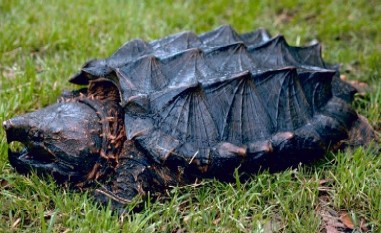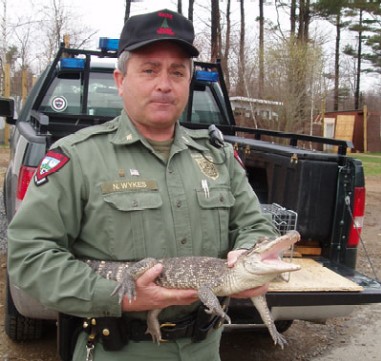
May 30, 2006
There is a May 30, 2006, news item that is one of those tidbits that have you scratching your head.
It is running in the China Daily under the headline "Bizarre Creature Puzzles Thousands."
The entire article (note: it sometimes becomes a deadlink, having mysteriously vanished 12 hours after it was first published) reads:
Thousands of residents of Tianmen, Hubei Province, have flocked to see a rare turtle-like creature caught by an elderly man in a nearby reservoir. Some think that the animal, weighing in at 8.3 kilograms, looks like an alligator. It has three rows of horns on its shell, a pair of eyes like an owl, and a tail measuring over 30 centimetres. It is currently being taken care of by local experts, who are trying to determine what exactly it is.
No photograph was published. [Update: See below. A photograph was discovered via another source.]
An animal weighing 8.3 kilograms is 18.3 pounds. A tail that is 30 centimeters long, of course, translates into something that is only a foot, that’s 12 inches, in length.
But is it a turtle, with a shell? Or an alligator? Alligators don’t have "rows of horns" on a shell. Could there be something lost in translation here?
There are two species of alligators; one is in China, the other in America. Chinese alligators (Alligator sinensis) live in a small area of northeastern China, in the provinces of Jiangsu, Zhejiang, and Anhui, but not Hubei. They are sometimes called Yangzi alligators because of where they are found, near the Yangzi River. Only about 150-200 exist in the wild, in scattered ponds, although the zoo captive population is said to be over 10,000 animals, throughout China.
This mystery Chinese reptile may be an out-of-place alligator snapping turtle (Macrochelys temminckii), which is the largest freshwater turtle in North America. One of the differences between the common snapping turtle (Chelydra serpentina serpentina) and the alligator snapping turtle is the three distinct ridges on the carapace of Macrochelys, whereas the common snapper has a smoother shell.

Alligator snapping turtle (Macrochelys temminckii) image from the U.S. Fish & Wildlife Service National Image Library – public domain. P.S. On the Internet Macrochelys is often incorrectly referred to as Macroclemmys or Macroclemys.
The "three rows of horns" on the shell of this mystery Chinese turtle does make it sound like an American alligator snapping turtle. Perhaps it is nothing more than an out-of-place pet, or more unlikely a new undiscovered species? What is the pet trade like for alligator snapping turtles among the Chinese?
It is the kind of story that comes my way where I wonder if I will ever hear about an outcome. Maybe someone in China will read this, and let us know if a firm identification is ever made.

An alligator, this one found in Maine in April 2006, doesn’t seem to look anything like the description of the creature captured in China.
UPDATE
See below the photograph published in the Chinese media of this "cryptid." It clearly is of an alligator snapping turtle. What such a healthy specimen is doing in a Chinese pond is a mystery. Thanks to Raymond Goh from API, Singapore, for this.

About Loren Coleman
Loren Coleman is one of the world’s leading cryptozoologists, some say “the” leading living cryptozoologist. Certainly, he is acknowledged as the current living American researcher and writer who has most popularized cryptozoology in the late 20th and early 21st centuries.
Starting his fieldwork and investigations in 1960, after traveling and trekking extensively in pursuit of cryptozoological mysteries, Coleman began writing to share his experiences in 1969. An honorary member of Ivan T. Sanderson’s Society for the Investigation of the Unexplained in the 1970s, Coleman has been bestowed with similar honorary memberships of the North Idaho College Cryptozoology Club in 1983, and in subsequent years, that of the British Columbia Scientific Cryptozoology Club, CryptoSafari International, and other international organizations. He was also a Life Member and Benefactor of the International Society of Cryptozoology (now-defunct).
Loren Coleman’s daily blog, as a member of the Cryptomundo Team, served as an ongoing avenue of communication for the ever-growing body of cryptozoo news from 2005 through 2013. He returned as an infrequent contributor beginning Halloween week of 2015.
Coleman is the founder in 2003, and current director of the International Cryptozoology Museum in Portland, Maine.
Filed under Breaking News, CryptoZoo News, Cryptozoology, Eyewitness Accounts, Out of Place, Swamp Monsters